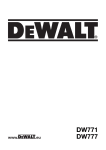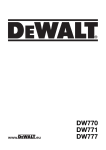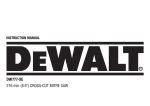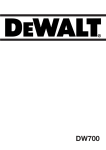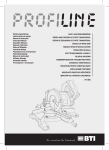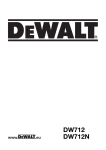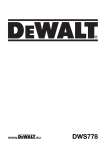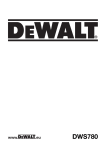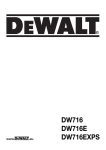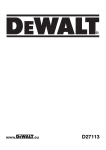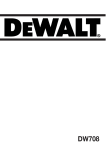Download DeWalt DW770 Technical data
Transcript
www. .eu DW770 DW771 DW777 English (original instructions) 6 Copyright DEWALT 2 Figure 1 q a d b dd q c e kk f s i g DW771 cc y j p k l ff o h m n Figure 2 r x w z dd bb aa kk y a5 v ee v t ff u v 1 Figure 3 hh Figure 4 ii kk jj ll ii oo nn mm mm Figure 5 Figure 6 pp nn rr qq Figure 7 Figure 8 bb aa z b Figure 9 ss gg h e f g 2 Figure 10 q Figure 11 q Figure 12 e v v uu tt n Figure 13 Figure 14 n yy i p m o ww l Figure 16 Figure 15 h a3 ee t p xx 3 Figure 17 Figure 18 a3 t h ee xx Figure 19 Figure 20 a4 a2 u a1 a2 Figure 21 4 Figure 22 zz Figure 24 Figure 23 Figure 25 1 kk Figure 26 2 Figure 27 3 5 EN GL I S H DW770, DW771, DW777 CROSS-CUT MITRE SAW Congratulations! You have chosen a DEWALT tool. Years of experience, thorough product development and innovation make DEWALT one of the most reliable partners for professional power tool users. Technical Data DW770 DW771 DW777 Voltage V 230 230 230 (U.K. & Ireland only) V 230/115 230/115 230/115 Type 1 2 2 Power input W 1600 1550/1400 1800/1600 Blade diameter mm 216 216 216 Blade bore mm 30 30 30 Max. blade speed min-1 6300 2600-5200 6300 Mitre (max. positions) left and right 50° 50° 50° Bevel (max. positions) left 48° 48° 48° Compound mitre bevel 45° 45° 45° mitre 45° 45° 45° Capacities cross-cut 90° mm 60 x 270 60 x 270 60 x 270 mitre 45° mm 60 x 190 60 x 190 60 x 190 mitre 48° mm 60 x 180 60 x 180 60 x 180 bevel 45° mm 48 x 270 48 x 270 48 x 270 bevel 48° mm 45 x 270 45 x 270 45 x 270 Overall dimensions mm 460 x 560 x 430 460 x 560 x 430 460 x 560 x 430 Weight kg 14.0 15.0 15.0 LPA (sound pressure) dB(A) 93 91 93 KPA (sound pressure uncertainty) dB(A) 3 3 3 LWA (acoustic power) dB(A) 104 102 104 KWA (acoustic power uncertainty) dB(A) 3.9 3.2 3.9 Vibration total values (triax vector sum) determined according to EN 61029: Vibration emission value ah ah = m/s² 2.1 2.1 Uncertainty K = m/s² 1.5 1.5 2.1 1.5 WARNING: The declared vibration emission level represents the main applications of the tool. However if the tool is used for different applications, with different accessories or poorly maintained, the vibration emission may differ. This may significantly increase the exposure level over the total working period. An estimation of the level of exposure to vibration should also take into account the times when the tool is switched off or when it is running but not actually doing the job. This may significantly reduce the exposure level over the total working period. Identify additional safety measures to protect the operator from the effects of vibration such as: maintain the tool and the accessories, keep the hands warm, organisation of work patterns. 6 The user has to ensure that this device is connected only to a power system which fulfils the requirement above. If necessary, the user can ask the public power supply company for the system impedance at the interface point. Definitions: Safety Guidelines The definitions below describe the level of severity for each signal word. Please read the manual and pay attention to these symbols. DANGER: Indicates an imminently hazardous situation which, if not avoided, will result in death or serious injury. WARNING: Indicates a potentially hazardous situation which, if not avoided, could result in death or serious injury. CAUTION: Indicates a potentially hazardous situation which, if not avoided, may result in minor or moderate injury. NOTICE: Indicates a practice not related to personal injury which, if not avoided, may result in property damage. Denotes risk of electric shock. Denotes risk of fire. Denotes sharp edges. EC-Declaration of Conformity MACHINERY DIRECTIVE DW770, DW771, DW777 DEWALT declares that these products described under Technical Data are in compliance with: 2006/42/EC, EN 61029-1, EN 61029-2-9. The vibration emission level given in this information sheet has been measured in accordance with a standardised test given in EN 61029 and may be used to compare one tool with another. It may be used for a preliminary assessment of exposure. Fuses Europe U.K. & Ireland U.K. & Ireland NOTE: This device is intended for the connection to a power supply system with maximum permissible system impedance Zmax of 0.25 Ohm at the interface point (power service box) of user’s supply. These products also comply with Directive 2004/108/EC and 2011/65/ EU. For more information, please contact DEWALT at the following address or refer to the back of the manual. The undersigned is responsible for compilation of the technical file and makes this declaration on behalf of DEWALT. Horst Grossmann Vice President Engineering and Product Development DEWALT, Richard-Klinger-Straße 11, D-65510, Idstein, Germany 01.01.2010 Safety Instructions WARNING! When using electric tools basic safety precautions should always be followed to reduce the risk of fire, electric shock and personal injury including the following. Read all these instructions before attempting to operate this product and save these instructions. 230 V tools 230 V tools 115 V tools 10 Amperes, mains 13 Amperes, in plugs 16 Amperes, mains ENGLI SH SAVE THIS MANUAL FOR FUTURE REFERENCE General Safety Rules 1. Keep work area clear. Cluttered areas and benches invite injuries. 2. Consider work area environment. Do not expose the tool to rain. Do not use the tool in damp or wet conditions. Keep the work area well lit (250 - 300 Lux). Do not use the tool where there is a risk of causing fire or explosion, e.g., in the presence of flammable liquids and gases. 3. Guard against electric shock. Avoid body contact with earthed surfaces (e.g., pipes, radiators, cookers and refrigerators). When using the tool under extreme conditions (e.g., high humidity, when metal swarf is being produced, etc.), electric safety can be improved by inserting an isolating transformer or a (FI) earth-leakage circuit-breaker. 4. Keep other persons away. Do not let persons, especially children, not involved in the work, touch the tool or the extension cord and keep them away from the work area. 5. Store idle tools. When not in use, tools must be stored in a dry place and locked up securely, out of reach of children. 6. Do not force the tool. It will do the job better and safer at the rate to which it was intended. 7. Use the right tool. Do not force small tools to do the job of a heavy duty tool. Do not use tools for purposes not intended; for example do not use circular saws to cut tree limbs or logs. 8. Dress properly. Do not wear loose clothing or jewellery, as these can be caught in moving parts. Non-skid footwear is recommended when working outdoors. Wear protective hair covering to contain long hair. 9. Use protective equipment. Always use safety glasses. Use a face or dust mask if working operations create dust or flying particles. If these particles might be considerably hot, also wear a heat-resistant apron. Wear ear protection at all times. Wear a safety helmet at all times. 10. Connect dust extraction equipment. If devices are provided for the connection of dust extraction and collecting equipment, ensure these are connected and properly used. 11. Do not abuse the cord. Never yank the cord to disconnect it from the socket. Keep the cord away from heat, oil and sharp edges. Never carry the tool by its cord. 12. Secure work. Where possible use clamps or a vice to hold the work. It is safer than using your hand and it frees both hands to operate the tool. 13. Do not overreach. Keep proper footing and balance at all times. 14. Maintain tools with care. Keep cutting tools sharp and clean for better and safer performance. Follow instructions for lubricating and changing accessories. Inspect tools periodically and if damaged have them repaired by an authorized service facility. Keep handles and switches dry, clean and free from oil and grease. 15. Disconnect tools. When not in use, before servicing and when changing accessories such as blades, bits and cutters, disconnect tools from the power supply. 16. Remove adjusting keys and wrenches. Form the habit of checking to see that adjusting keys and wrenches are removed from the tool before operating the tool. 17. Avoid unintentional starting. Do not carry the tool with a finger on the switch. Be sure that the tool is in the “off” position before plugging in. 18. Use outdoor extension leads. Before use, inspect the extension cable and replace if damaged. When the tool is used outdoors, use only extension cords intended for outdoor use and marked accordingly. 19. Stay alert. Watch what you are doing. Use common sense. Do not operate the tool when you are tired or under the influence of drugs or alcohol. 20. Check for damaged parts. Before use, carefully check the tool and mains cable to determine that it will operate properly and perform its intended function. Check for alignment of moving parts, binding of moving parts, breakage of parts, mounting and any other conditions that may affect its operation. A guard or other part that is damaged should be properly repaired or replaced by an authorized service centre unless otherwise indicated in this instruction manual. Have defective switches replaced by an authorized service centre. Do not use the tool if the switch does not turn it on and off. Never attempt any repairs yourself. WARNING! The use of any accessory or attachment or performance of any operation with this tool other than those recommended in this instruction manual may present a risk of personal injury. 21. Have your tool repaired by a qualified person. This electric tool complies relevant safety rules. Repairs should only be carried out by qualified persons using original spare parts; otherwise this may result in considerable danger to the user. Additional Safety Rules for Mitre Saws • The machine is provided with a special configured power supply cord which can only be replaced by the manufacturer or its authorised service agent. • Do not use the saw to cut other materials than those recommended by the manufacturer. • Do not operate the machine without guards in position, or if guards do not function or are not maintained properly. • Ensure that the arm is securely fixed when performing bevel cuts. • Keep the floor area around the machine level, well-maintained and free of loose materials, e.g., chips and cut-offs. • Select the correct blade for the material to be cut. • Use correctly sharpened saw blades. Observe the maximum speed mark on the saw blade. • Make sure all locking knobs and clamp handles are tight before starting any operation. • Never place either hand in the blade area when the saw is connected to the electrical power source. • Never attempt to stop a machine in motion rapidly by jamming a tool or other means against the blade; serious accidents can occur. • Before using any accessory consult the instruction manual. The improper use of an accessory can cause damage. • Use a holder or wear gloves when handling a saw blade or rough material. • Ensure that the saw blade is mounted correctly before use. • Make sure that the blade rotates in the correct direction. • Do not use blades of larger or smaller diameter than recommended. For the proper blade rating refer to the technical data. Use only the blades specified in this manual, complying with EN 847-1. • Consider applying specially designed noise-reduction blades. • Do not use HIGH SPEED STEEL blades. • Do not use cracked or damaged saw blades. • Do not use any abrasive or diamond discs. • Use only saw blades where the marked speed is at least equal to the speed marked on the saw. 7 EN GL I S H • Never use your saw without the kerf plate. • Raise the blade from the kerf in the workpiece prior to releasing the switch. In spite of the application of the relevant safety regulations and the implementation of safety devices, certain residual risks cannot be avoided. These are: • Before each cut ensure that the machine is stable. – Impairment of hearing. • Do not wedge anything against the fan to hold the motor shaft. – Risk of accidents caused by the uncovered parts of the rotating saw blade. • The blade guard on your saw will automatically raise when the arm is brought down; it will lower over the blade when head lock up release lever (b) is pushed. • Never raise the blade guard manually unless the saw is switched off. The guard can be raised by hand when installing or removing saw blades or for inspection of the saw. • Check periodically that the motor air slots are clean and free of chips. • Replace the kerf plate when worn. • Disconnect the machine from the mains before carrying out any maintenance work or when changing the blade. – Risk of injury when changing the unprotected saw blade. – Risk of squeezing fingers when opening the guards. – Health hazards caused by breathing dust developed when sawing wood, especially oak, beech and MDF. The following factors increases the risk of breathing problems: – No dust extractor connected when sawing wood – Insufficient dust extraction caused by uncleaned exhaust filters Markings on Tool The following pictograms are shown on the tool: • Never perform any cleaning or maintenance work when the machine is still running and the head is not in the rest position. Read instruction manual before use. • When fitted with laser, no exchange with different type of laser permitted. Repairs shall only be carried out by the laser manufacturer or an authorized agent. Wear ear protection. • Connect the saw to a dust collection device when sawing wood. Always consider factors which influence exposure of dust such as: Wear eye protection. -– type of material to be machined (chip board produces more dust than wood); -– sharpness of the saw blade; Carrying point -– correct adjustment of the saw blade, -– dust extractor with air velocity not less than 20 m/s. Ensure that the local extraction as well as hoods, baffles and chutes are properly adjusted. • Please be aware of the following factors influencing exposure to noise: DATE CODE POSITION (FIG. 2) The Date Code (A5), which also includes the year of manufacture, is printed into the housing. Example: 2012 XX XX -– use saw blades designed to reduce the emitted noise; Year of Manufacture -– use only well sharpened saw blades; • Machine maintenance shall be conducted periodically; Package Contents • Provide adequate general or localized lighting; The package contains: • Ensure the operator is adequately trained in the use, adjustment and operation of the machine; 1 Partly assembled machine • Ensure that any spacers and spindle rings are suitable for the purpose as stated in this manual. 1 216 mm TCT saw blade 1 Material clamp • Refrain from removing any cut-offs or other parts of the workpiece from the cutting area while the machine is running and the saw head is not in the rest position 2 Dust extraction nozzles (optional for DW770) • Never cut workpieces shorter than 150 mm. 1 Exploded drawing • Without additional support the machine is designed to accept the maximum workpiece size of: • Check for damage to the tool, parts or accessories which may have occurred during transport. – Height 60 mm by width 270 mm by length 500 mm – Longer workpieces need to be supported by suitable additional table, e.g. DE7023. Always clamp the workpiece safely. • In case of an accident or machine failure, immediately turn the machine off and disconnect machine from the power source. • Report the failure and mark the machine in suitable form to prevent other people from using the defective machine. • When the saw blade is blocked due to abnormal feed force during cutting, turn the machine off and disconnect it from power supply. Remove the workpiece and ensure that the saw blade runs free. Turn the machine on and start new cutting operation with reduced feed force. 1 Instruction manual • Take the time to thoroughly read and understand this manual prior to operation. Description (fig. 1, 2, 9) WARNING: Never modify the power tool or any part of it. Damage or personal injury could result. a. On/off switch b. Guard lock up release lever c. Carrying handle d. Fixed upper guard e. Outer flange • Never cut light alloy, especially magnesium. f. Blade bolt • Whenever the situation allows, mount the machine to a bench using bolts with a diameter of 8 mm and 80 mm in length. g. Lower blade guard Residual Risks The following risks are inherent to the use of saws: – injuries caused by touching the rotating parts 8 2 Hex key 4/6 mm h. Saw blade i. Sliding fence lock knob j. Fixed table k. kerf plate ENGLI SH l. Mitre arm m. Mitre latch In case of cord replacement the tool must only be repaired by an authorized service agent or by qualified electrician. n. Rotating table/mitre arm The following cords are mandatory: o. Mitre scale DW770: H07RN-F, 2x1.0 mm² p. Sliding fence DW770 LX: H05RR-F, 2x1.5 mm² q. Dust extraction nozzle (optional for DW770) DW777 / DW771: H07RN-F, 2x1.0 mm² r. Traverse lock DW777 LX / DW771 LX: H05RR-F, 2x1.5 mm² t. Bevel clamp handle Mains Plug Replacement (U.K. & Ireland Only) u. Bevel scale If a new mains plug needs to be fitted: s. Guard lock up hook v. Bench mounting holes • Safely dispose of the old plug. w. Lock down button • Connect the brown lead to the live terminal in the plug. x. Traverse bars • Connect the blue lead to the neutral terminal. y. Saw head z. Hex keys aa. Cable clamp bb. Cable cc. Speed control dial (DW771 only) dd. Padlock hole ee. Override button ff. Carrying handle (left and right) gg. Inner flange kk. Material clamp OPTIONAL ACCESSORITES (FIG. 3–6) hh. Table end plate WARNING: No connection is to be made to the earth terminal. Follow the fitting instructions supplied with good quality plugs. Recommended fuse: 13 A. Fitting a Mains Plug to 115 V Units (U.K. and Ireland Only) • The plug fitted should be comply with BS EN 60309 (BS4343), 16 Amps, earthing contact position 4h. WARNING: Always ensure that the cable clamp is correctly and securely fitted to the sheath of the cable. Using an Extension Cable jj. Material support plate If an extension cable is required, use an approved 3–core extension cable suitable for the power input of this tool (see Technical Data).The minimum conductor size is 1.5 mm2; the maximum length is 30 m. ll. Swivelling stop When using a cable reel, always unwind the cable completely. ii. Support guide rails mm. Adjustable stand 760 mm (max. height) nn. Legstand oo. Length stop for short workpieces (to be used with guide rails [ii]) pp. Roller table qq. Dust extraction tubes rr. Three-way connector INTENDED USE Your DEWALT Cross-Cut Mitre Saw has been designed for professional cutting wood, wood products and plastics. It performs the sawing operations of cross-cutting, bevelling and mitring easily, accurately and safely. This unit is designed for use with a nominal blade diameter 216 mm carbide tip blade. DO NOT use under wet conditions or in presence of flammable liquids or gases. These miter saws are professional power tools. DO NOT let children come into contact with the tool. Supervision is required when inexperienced operators use this tool. WARNING! Do not use the machine for purposes other than intended. • This product is not intended for use by persons (including children) suffering from diminished physical, sensory or mental abilities; lack of experience, knowledge or skills unless they are supervised by a person responsible for their safety. Children should never be left alone with this product. Electrical Safety The electric motor has been designed for one voltage only. Always check that the power supply corresponds to the voltage on the rating plate. Your tool is double insulated in accordance with EN 61029; therefore no earth wire is required. ASSEMBLY WARNING: To reduce the risk of injury, turn unit off and disconnect machine from power source before installing and removing accessories, before adjusting or changing set-ups or when making repairs. Be sure the trigger switch is in the OFF position. An accidental startup can cause injury. Unpacking The motor and guards are already assembled onto the base. Cable Clamp (fig. 7) Insert the cable (bb) into the cable clamp (aa). Allow enough cable for the saw head to travel, then tighten the clamp by means of the screw. Bench Mounting (fig. 2) 1. Holes (v) are provided in all four feet to facilitate bench mounting. Two different sized holes are provided to accommodate different sizes of bolts. Use either hole; it is not necessary to use both. Bolts with a diameter of 8 mm and 80 mm in length is suggested. Always mount your saw firmly to prevent movement. To enhance the portability, the tool can be mounted to a piece of 12.5 mm or thicker plywood which can then be clamped to your work support or moved to other job sites and reclamped.. 2. When mounting your saw to a piece of plywood, make sure that the mounting screws do not protrude from the bottom of the wood. The plywood must sit flush on the work support. When clamping the saw to any work surface, clamp only on the clamping bosses where the mounting screw holes are located. Clamping at any other point will interfere with the proper operation of the saw. 3. To prevent binding and inaccuracy, be sure the mounting surface is not warped or otherwise uneven. If the saw rocks on the surface, place a thin piece of material under one saw foot until the saw is firm on the mounting surface. 9 EN GL I S H Mounting the Saw Blade (fig. 1, 8–10) WARNING: To reduce the risk of injury, turn unit off and disconnect machine from power source before installing and removing accessories, before adjusting or changing set-ups or when making repairs. Be sure the trigger switch is in the OFF position. An accidental start-up can cause injury. Checking and Adjusting the Blade to the Fence (fig. 2, 14, 15) 1. Slacken the mitre latch (m). 2. Place your thumb on the mitre arm (l) and squeeze the mitre latch (m) to release the rotating table/mitre arm (n). 3. Swing the mitre arm until the latch locates it at the 0° mitre position. WARNING: The teeth of a new blade are very sharp and can be dangerous. 4. Pull down the head and lock it in this position using the lock down button (w). WARNING: Be aware the saw blade shall be replaced in the described way only. Only use saw blades as specified under Technical Data; Cat.no.: DT4320 is suggested. 5. Check that the two 0° markings (ww) on the mitre scale (o) are just visible. 1. Insert the 6 mm hex key (z) into the opposite location of the blade shaft and hold it (fig. 8). 2. Loosen the blade bolt (f) by turning clockwise. Remove the blade bolt (f) and the outer flange (e). 3. Press the lower guard lock up release lever (b) to raise the lower blade guard (g) and remove the saw blade (h). 4. Install the new saw blade onto the shoulder provided on the inner flange (gg) making sure that the teeth at the bottom edge of the blade are pointing towards the fence (away from the operator). 5. Replace the outer flange (e), making sure that the location lugs (ss) are engaged correctly, one on each side of the motor shaft. 6. Tighten the blade bolt (f) by turning anti-clockwise while holding the 6 mm hex key (z) engaged with your other hand (fig. 10). ADJUSTMENTS WARNING: To reduce the risk of injury, turn unit off and disconnect machine from power source before installing and removing accessories, before adjusting or changing set-ups or when making repairs. Be sure the trigger switch is in the OFF position. An accidental start-up can cause injury. Your mitre saw was accurately adjusted at the factory. If readjustment due to shipping and handling or any other reason is required, follow the steps below to adjust your saw. Once made, these adjustments should remain accurate. Adjusting the Traverse Bars for Constant Cutting Depth (fig. 1, 2, 11, 12) The blade must run at a constant cutting depth along the full length of the table and must not touch the fixed table at the rear of the slot or at the front of the rotating arm. To achieve this, the traverse arms must be perfectly parallel to the table when the saw head is fully depressed. 1. Press the lower guard lock up release lever (b) (fig. 1). 2. Press the saw head fully to the rear position and measure the height from the rotating table (n) to the bottom of the outer flange (e) (fig. 11). 3. Turn the saw head traverse lock (r) (fig. 2). 4. Keeping the saw head fully depressed, pull the head to the end of its travel. 5. Measure the height indicated in figure 11 again. Both values should be identical. 6. If adjustment is required, proceed as follows (fig.12): a. Loosen the locknut (tt) in the bracket (uu) under the upper dust extraction nozzle (q) and adjust the screw (v v) as required, proceeding in small steps. b. Tighten the locknut (tt). WARNING: Always check that the blade does not touch the table at the rear of the slot or at the front of the rotating arm at 90° vertical and 45° bevel positions. Do not switch on before having checked this! 6. Place a square (xx) against the left side of the fence (p) and blade (h). WARNING: Do not touch the tips of the blade teeth with the square. 7. If adjustment is required, proceed as follows: a. Loosen the screws (yy) and move the scale/mitre arm assembly left or right until the blade is at 90° to the fence as measured with the square (fig. 14). b. Retighten the screws (yy). Checking and Adjusting the Blade to the Table (fig. 16–19) 1. Loosen the bevel clamp handle (t) (fig. 16). 2. Press the saw head to the right to ensure it is fully vertical and tighten the bevel clamp handle. 3. Place a set square (xx) on the table and up against the blade (h) (fig. 17). WARNING: Do not touch the tips of the blade teeth with the square. 4. If adjustment is required, proceed as follows: a. Loosen the bevel clamp handle (t) and turn the vertical position adjustment stop screw (zz) in or out until the blade is at 90° to the table as measured with the square. b. If the bevel pointer (a1) does not indicate zero on the bevel scale (u), loosen the screws (a2) that secure the scale and move the scale as necessary. Checking and Adjusting the Bevel Angle (fig. 1, 18, 19) The bevel override allows the max. bevel angle to be set at 45° or 48° as required. • Left = 45° • Right = 48° 1. Make sure the override knob (a3) is located in the left position. 2. Loosen the bevel clamp handle (t) and move the saw head to the left. 3. This is the 45° bevel position. 4. If adjustment is required, turn the stopscrew (a4) in or out as necessary until the pointer (a1) indicates 45°. WARNING: The guide grooves can become clogged with sawdust. Use a stick or some low pressure air to clear the guide grooves. Prior to Operation WARNING: • Install the appropriate saw blade. Do not use excessively worn blades.The maximum rotation speed of the tool must not exceed that of thesaw blade. Adjusting the Fence (fig. 13) • Do not attempt to cut excessively small pieces. Turn the sliding fence lock knob (i) anti-clockwise to loosen. Move the sliding fence (p) to a position that avoids the blade cuts it,then tighten the fence lock knob by turning clockwise. • Allow the motor to reach full speed before cutting. • Allow the blade to cut freely. Do not force. • Make sure all locking knobs and clamp handles are tight. • Secure the workpiece. 10 ENGLI SH • Although this saw will cut wood and many nonferrous materials,these operating instructions refer to the cutting of wood only. The sameguide-lines apply to the other materials. Do not cut ferrous (iron and steel) materials or masonry with this saw! Do not use any abrasive discs! • Make sure to use the kerf plate. Do not operate the machine if the kerf slot is wider than 10 mm. • Placing the workpiece on a piece of wood will increase the capacities to 300 mm. OPERATION Instructions for Use WARNING: Always observe the safety instructions and applicable regulations. WARNING: To reduce the risk of injury, turn unit off and disconnect machine from power source before installing and removing accessories, before adjusting or changing set-ups or when making repairs. Be sure the trigger switch is in the OFF position. An accidental start-up can cause injury. The attention of UK users is drawn to the “woodworking machines regulations 1974” and any subsequent amendments. Ensure the machine is placed to satisfy your ergonomic conditions in terms of table height and stability. The machine site shall be chosen so that the operator has a good overview and enough free surrounding space around the machine that allows handling of the workpiece without any restrictions. To reduce effects of increased vibration, make sure the environment is not too cold, the machine and accessory are well maintained and the workpiece size is suitable for this machine. Switching On and Off (fig. 1) A hole (dd) is provided in the on/off switch (a) for insertion of a padlock to lock the tool. 1. To run the tool, press the on/off switch (a). 2. To stop the tool, release the switch. SPEED CONTROL DIAL (DW771 ONLY) The speed control dial (cc) can be used for advance setting of the required range of speed. Turn the speed control dial (cc) to the desired range, which is indicated by a number (1–5). • Use high speeds for sawing soft materials such as wood. • Use low speeds for sawing hardwood. Body and Hand Position Proper positioning of your body and hands when operating the mitre saw will make cutting easier, more accurate and safer. WARNING: • Never place your hands near the cutting area. • Place your hands no closer than 150 mm from the blade. • Hold the workpiece tightly to the table and the fence when cutting. Keep your hands in position until the switch has been released and the blade has completely stopped. • Always make dry runs (without power) before finish cuts so that you can check the path of the blade. • Do not cross your hands. • Keep both feet firmly on the floor and maintain proper balance. • As you move the saw arm left and right, follow it and stand slightly to the side of the saw blade. Basic Saw Cuts VERTICAL STRAIGHT CROSS CUT (FIG. 1, 20) NOTE: Use 216 mm saw blades with 30 mm arbor holes to obtain the desired cutting capacities. 1. Slacken the mitre latch (m) and subsequently lift it up. 2. Engage the mitre latch (m) at the 0° position and fasten the mitre latch. 3. Place the wood to be cut against the fence (p). 4. Take hold of the carrying handle (c) and press the guard lock up release lever (b) to release the guard. Press the trigger switch (a) to start the motor. It is recommended to start the cut near the fence. 5. Depress the head to allow the blade to cut through the timber and enter the plastic kerf plate (k). 6. When the head is fully depressed, slowly pull it across to complete the cut. 7. After completing the cut, release the switch and wait for the saw blade to come to a complete standstill before returning the head to its upper rest position. WARNING: • For some types of plastic profiles, it is advisable to follow the sequence in reverse order. • The lower blade guard is designed to close quickly when the lever (b) is released. If it does not close within 1 second, have the saw serviced by an authorized DEWALT repair agent. VERTICAL MITRE CROSS-CUT (FIG. 1, 21) 1. Squeeze the mitre latch (m). Move the arm left or right to the required angle. 2. The mitre latch will automatically locate at 0°, 15°, 22.5°, 31.62°, 45° and 50° both left and right. If any intermediate angle is required hold the head firmly and lock by fastening the mitre latch. 3. Always ensure that the mitre lock lever is locked tightly before cutting. 4. Proceed as for a vertical straight cross-cut. WARNING: When mitring the end of a piece of wood with a small off-cut, position the wood to ensure that the off-cut is to the side of the blade with the greater angle to the fence, i.e.: left mitre, off-cut to the right right mitre, off-cut to the left BEVEL CROSS-CUTS (FIG. 18, 22) Bevel angles can be set from 0° to 48° to the left. Bevels up to 45° can be cut with the mitre arm set between zero and a maximum of 45° mitre position right or left. 1. Loosen the bevel clamp handle (t) and set the bevel as desired. 2. Set the override button (ee) if required. 3. Hold the head firmly and do not allow it to fall. 4. Tighten the bevel clamp handle (t) firmly. 5. Proceed as for a vertical straight cross-cut. Quality of Cut The smoothness of any cut depends on a number of variables, i.e. the material being cut. When smoothest cuts are desired for moulding andother precision work, a sharp (60-tooth carbide) blade and a slower, even cutting rate will produce the desired results. WARNING: Ensure that the material does not creep while cutting; clamp it securely in place. Always let the blade come to a full stop before raising the arm. If small fibres of wood still split out at the rear of the workpiece, stick a piece of masking tape on the wood where the cut will be made. Saw through the tape and carefully remove tape when finished. Clamping the Workpiece (fig. 3, 25–27) WARNING: Always use a material clamp. For best results use the material clamp (kk) made for use with your saw. TO INSTALL CLAMP 1. Insert it into the hole behind the fence. The clamp (kk) should be facing toward the back of the mitre saw. Ensure the groove on the clamp rod is fully inserted into the base of the mitre saw. If the groove is visible, the clamp will not be secure. 2. Rotate the clamp 180º toward the front of the mitre saw. 11 EN GL I S H 3. Loosen the knob to adjust the clamp up or down, then use the fine adjust knob to firmly clamp the workpiece. NOTE: Place the clamp on the right side of the base when beveling. ALWAYS MAKE DRY RUNS (UNPOWERED) BEFORE FINISH CUTS TO CHECK THE PATH OF THE BLADE. ENSURE THE CLAMP DOES NOT INTERFERE WITH THE ACTION OF THE SAW OR GUARDS. Compound Mitre (fig. 23, 24) WARNING: If the cutting angle varies from cut to cut, check that the bevel clamp handle and the mitre clamping knob are securely tightened. These must be tightened after making any changes in bevel or mitre. • The chart shown below will assist you in selecting the proper bevel and mitre settings for common compound mitre cuts. • To use the chart, select the desired angle “A” (fig. 24) of your project and locate that angle on the appropriate arc in the chart. From that point follow the chart straight down to find the correct bevel angle and straight across to find the correct mitre angle. 5 10 15 20 25 30 35 40 65 40 50 35 45 35 40 6 SIDED BOX 30 35 70 75 30 65 80 85 30 25 50 25 65 45 20 55 35 50 45 15 15 30 40 15 25 35 10 20 40 60 70 75 20 80 85 55 60 25 30 8 SIDED BOX 10 15 20 15 5 10 20 25 ANGLE OF SIDE OF BOX (ANGLE"A") SET THIS MITER ANGLE ON SAW 55 60 40 10 5 5 10 5 5 0 5 10 15 20 25 – Material support plates (jj). – Table end plate (hh) for supporting the rails (also when working on an existing bench). 30 35 40 – Swivelling stop (ll). 1. Place your saw on the legstand and fit the guide rails. 2. Firmly screw the material support plates (jj) to the guide rails (ii). 3. The material clamp (kk) now functions as a length stop. 4. Install the table end plates (hh). 5. Install the swivelling stop (ll) to the rear rail. 6. Use the swivelling stop (ll) to adjust the length of medium and long workpieces. It can be adjusted sideways or swung out of the way when not in use. Dust Extraction (fig. 1, 6) 45 SQUARE BOX 70 75 80 85 0 – Stands (mm) to support the guide rails. Do not use the stands to support the machine! The height of the stands is adjustable. – Material clamp (kk). This cut is a combination of a mitre and a bevel cut. This is the type of cut used to make frames or boxes with slanting sides like the one shown in figure 23. 45 – Guide rails (500 or 1,000 mm) (ii). 45 SET THIS BEVEL ANGLE ON SAW WARNING: Whenever possible, connect a dust extraction device designed in accordance with the relevant regulations regarding dust emission. Connect a dust collection device designed in accordance with the relevant regulations. The air velocity of externally connected systems shall be 20m/s +/- 2 m/s. Velocity to be measured in the connection tube at the point of connection, with the tool connected but not running. A separate dust kit is available as an option (DE7777). 1. Fit the dust extraction tubes (qq) to the nozzles (q); the longer hose to upper nozzle. 2. Connect the hoses to the three-way connector (rr). Transporting (fig. 1) WARNING: In order to conveniently carry the mitre saw, the base is provided with two hand indentations (ff). Never use guards to lift or transport the mitre saw. 1. To transport the saw, set the bevel and mitre positions to 0°. 1. Set your saw to the prescribed angles and make a few trial cuts. 2. Press the lower guard lock up release lever (b) (fig.1). 2. Practice fitting the cut pieces together. 3. Press the head down and press the lock down button (w) (fig. 2). Example: To make a four-sided box with 25° exterior angles (angle “A”) (fig. 24), use the upper right arc. Find 25° on the arc scale. Follow the horizontal intersecting line to either side to get the mitre angle setting on the saw (23°). Likewise follow the vertical intersecting line to the top or bottom to get the bevel angle setting on the saw (40°). Always try cuts on a few scrap pieces of wood to verify the settings on the saw. WARNING: Never exceed the compound mitre limits of 45° bevel with 45° left or right mitre. Support for Short and Long Pieces (fig. 3, 4) CUTTING SHORT MATERIAL It is advisable to use the length stop (oo) for short workpieces both for batch sawing and for short individual workpieces of different lengths. The length stop can only be used in conjunction with a pair of optional guide rails (ii). 4. Bring the saw blade to rest position and press the traverse lock (r). MAINTENANCE Your DEWALT power tool has been designed to operate over a long period of time with a minimum of maintenance. Continuous satisfactory operation depends upon proper tool care and regular cleaning. WARNING: To reduce the risk of injury, turn unit off and disconnect machine from power source before installing and removing accessories, before adjusting or changing set-ups or when making repairs. Be sure the trigger switch is in the OFF position. An accidental start-up can cause injury. WARNING: If the saw blade is worn replace it with a new sharp blade. CUTTING LARGE MATERIAL WARNING: To reduce the risk of injury, always support long workpieces. Lubrication Your power tool requires no additional lubrication. Figure 3 shows the ideal configuration for sawing long workpieces when the saw is used free-standing (all items available as an option). These items (except the legstand and the material clamp) are required both on the infeed and the outfeed side: – Legstand (nn) (supplied with mounting instructions). 12 ENGLI SH Should you find one day that your DEWALT product needs replacement, or if it is of no further use to you, do not dispose of it with household waste. Make this product available for separate collection. Cleaning Before use, carefully check the upper blade guard, movable lower blade guard as well as the dust extraction tube to determine that it will operate properly. Ensure that chips, dust or workpiece particle cannot lead to blockage of one of the functions. In case of workpiece fragments jammed between saw blade and guards disconnect the machine from the power supply and follow the instructions given in section Mounting the saw blade. Remove the jammed parts and reassembling the saw blade. WARNING: Blow dirt and dust out of the main housing with dry air as often as dirt is seen collecting in and around the air vents. Wear approved eye protection and approved dust mask when performing this procedure. WARNING: Never use solvents or other harsh chemicals for cleaning the non-metallic parts of the tool. These chemicals may weaken the materials used in these parts. Use a cloth dampened only with water and mild soap. Never let any liquid get inside the tool; never immerse any part of the tool into a liquid. WARNING: To reduce the risk of injury, regularly clean the table top. WARNING: To reduce the risk of injury, regularly clean the dust collection system. Optional Accessories WARNING: Since accessories, other than those offered by DEWALT, have not been tested with this product, use of such accessories with this tool could be hazardous. To reduce the risk of injury, only DEWALT, recommended accessories should be used with this product. Using the Roller Table (fig. 3–5) The roller table (pp) makes the handling of large and long pieces of wood very easy (fig. 5). It can be connected either to the left or to the right of the machine. The roller table requires the use of the optional legstand (fig. 3). WARNING: Assemble the roller table following the instructions supplied with the legstand. • Replace the short support bars provided with the legstand with the irregular rails from the table on the side the table is to be used. • Follow all instructions provided with the roller table. RANGE OF SAW BLADES AVAILABLE (RECOMMENDED BLADES) Type of blade Blade dimensions (diameter x bore x no. of teeth) DT4222 series 40 216x30x24 DT4286 series 40 DT4320 series 60 216x30x80 216x30x48 DT4350 series 60 216x30x60 Usage For general purpose, ripping and cross-cutting of wood and plastics TCG for use with aluminum ATB for fine cutting of manmade and natural wood TCG for extra fine cutting of manmade and natural wood Separate collection of used products and packaging allows materials to be recycled and used again. Re-use of recycled materials helps prevent environmental pollution and reduces the demand for raw materials. Local regulations may provide for separate collection of electrical products from the household, at municipal waste sites or by the retailer when you purchase a new product. DEWALT provides a facility for the collection and recycling of DEWALT products once they have reached the end of their working life. To take advantage of this service please return your product to any authorised repair agent who will collect them on our behalf. You can check the location of your nearest authorised repair agent by contacting your local DEWALT office at the address indicated in this manual. Alternatively, a list of authorised DEWALT repair agents and full details of our after-sales service and contacts are available on the Internet at: www.2helpU.com. GUARANTEE DEWALT is confident of the quality of its products and offers an outstanding guarantee for professional users of the product. This guarantee statement is in addition to and in no way prejudices your contractual rights as a professional user or your statutory rights as a private non-professional user. The guarantee is valid within the territories of the Member States of the European Union and the European Free Trade Area. • 30 DAY NO RISK SATISFACTION GUARANTEE • If you are not completely satisfied with the performance of your DEWALT tool, simply return it within 30 days, complete with all original components, as purchased, to the point of purchase, for a full refund or exchange. The product must have been subject to fair wear and tear and proof of purchase must be produced. • ONE YEAR FREE SERVICE CONTRACT • If you need maintenance or service for your DEWALT tool, in the 12 months following purchase, you are entitled to one service free of charge. It will be undertaken free of charge at an authorised DEWALT repair agent. Proof of purchase must be produced. Includes labour. Excludes accessories and spare parts unless failed under warranty. • ONE YEAR FULL WARRANTY • If your DEWALT product becomes defective due to faulty materials or workmanship within 12 months from the date of purchase, DEWALT guarantees to replace all defective parts free of charge or – at our discretion – replace the unit free of charge provided that: • • • • • The product has not been misused; The product has been subject to fair wear and tear; Repairs have not been attempted by unauthorised persons; Proof of purchase is produced; The product is returned complete with all original components. If you wish to make a claim, contact your seller or check the location of your nearest authorised DEWALT repair agent in the DEWALT catalogue or contact your DEWALT office at the address indicated in this manual. A list of authorised DEWALT repair agents and full details of our after-sales service is available on the Internet at: www.2helpU.com. Consult your dealer for further information on the appropriate accessories. Protecting the Environment Separate collection. This product must not be disposed of with normal household waste. 13 Belgique et Luxembourg België en Luxemburg Danmark Deutschland Ελλάς España France Schweiz Suisse Svizzera Ireland Italia Nederlands Norge Österreich Portugal Suomi Sverige Türkiye United Kingdom Middle East Africa N161492 Black & Decker - DEWALT Nieuwlandlaan 7, IZ Aarschot B156 B-3200 Aarschot Dutch Tel: 32 70 220 063 French Tel: 32 70 220 062 DEWALT Sluseholmen 2-4 2450 København SV DEWALT Richard Klinger Str. 11 65510 Idstein Black & Decker (Ελλάς) Α.Ε. Τηλ: Στράβωνος 7 & Βουλιαγμένης 159 Service: Γλυφάδα 16674, Αθήνα Φαξ: DEWALT Parque de Negocios “Mas Blau” Edificio Muntadas, c/Bergadá, 1, Of. A6 08820 El Prat de Llobregat (Barcelona) DEWALT 5, allée des hêtres BP 30084, 69579 Limonest Cedex DEWALT In der Luberzen 40 8902 Urdorf DEWALT Calpe House Rock Hill Black Rock, Co. Dublin DEWALT c/o Energypark Building 03 sud, Via Monza 7/A, 20871 Vimercate (MB), IT Black & Decker - DEWALT Joulehof 12 4600 AB Bergen Op Zoom DEWALT Postboks 4613, Nydalen 0405 Oslo DEWALT Werkzeug Vertriebsges m.b.H Oberlaaerstrasse 248 A-1230 Wien DEWALT Centro de Escritórios de Sintra Avenida Almirante Gago Coutinho, 132/134, Edifício 142710-418 Sintra 2710-418 Lisboa DEWALT Tekniikantie 12 02150 Espoo, Finland DEWALT Box 94 431 22 Mölndal KALE Hırdavat ve Makina A.Ş. Defterdar Mah. Savaklar Cad. No:15 Edirnekapı / Eyüp / İSTANBUL 34050 TÜRKİYE DEWALT Tel: 210 Bath Road; Slough, Berks SL1 3YD Fax: DEWALT P.O. Box - 17164, Jebel Ali (South Zone), Dubai, UAE 30 210 8981-616 30 210 8981-616 30 210 8983-570 Fax: 32 70 225 585 Fax: 32 70 222 441 www.dewalt.be Tlf: 70201511 Fax: 70224910 www.dewalt.dk Tel: 06126-21-1 Fax: 06126-21-2770 www.dewalt.de www.dewalt.gr Tel: 934 797 400 Fax: 934 797 419 www.dewalt.es Tel: 04 72 20 39 20 Fax: 04 72 20 39 00 www.dewalt.fr Tel: 01 - 730 67 47 Fax: 01 - 730 70 67 www.dewalt.ch Tel: 00353-2781800 Fax: 00353-2781811 www.dewalt.ie Tel: 800-014353 Fax: 39 039 9590 317 www.dewalt.it Tel: 31 164 283 063 Fax: 31 164 283 200 www.dewalt.nl Tel: 45 25 13 00 Fax: 45 25 08 00 www.dewalt.no Tel: 01 - 66116 - 0 Fax: 01 - 66116 - 14 www.dewalt.at Tel: 214 66 75 00 Fax: 214 66 75 75 www.dewalt.pt 01753-56 70 55 01753-57 21 12 Puh: 010 400 430 Faksi: 0800 411 340 www.dewalt.fi Tel: 031 68 61 00 Fax: 031 68 60 08 www.dewalt.se Tel: 0212 533 52 55 Faks: 0212 533 10 05 www.dewalt.com.tr www.dewalt.co.uk Tel: 971 4 8863030 Fax: 971 4 8863333 www.dewalt.ae 02/12
















